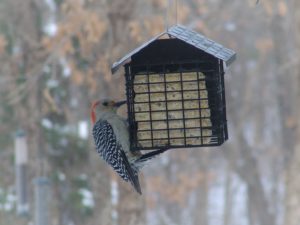How to help your birds this winter
Views: 903
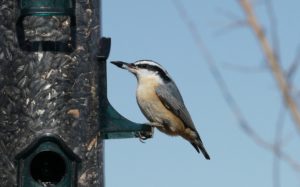
It seems like winter is already here in parts of the country. Most migrant birds left their summer nesting areas some time ago, but others are still on the move. I am still seeing V’s of ducks and geese flying south here in the central flyway, and more juncos show up in my yard daily. Soon the transition from summer to winter populations will be complete, even here in the south. So, it’s time to think about how to help your birds in winter.
Of course, birds are well-adapted to surviving winter without our assistance, but there are some things we can do to help them out, to their benefit and our own. Finding food, water, and shelter are birds’ survival priorities, and if we can help them meet their needs, we get to enjoy their colorful presence in our yards and gardens for the season. It’s hard to beat the beautiful contrasting colors of cardinals and jays against a snow-covered spruce, pine tree, or cedar.
Feeding birds in winter
Birds need to build and maintain a healthy layer of fat in order to survive cold temperatures. They also need calories to burn, just like people, in order to stay warm. Food is energy; easy food is easy energy. Providing birds with reliable, easy access to healthy food is a beneficial way to help birds any time of the year, but especially in winter when natural food sources may be scarce or difficult to access due to snow and ice.
Different birds have different feeding strategies, and they rely on different types of food. So, you may not be able to provide all birds with the food they need. However, many common backyard birds eat a combination of seeds, berries, fruit, nuts, grains, insects, and/or fats. Put quite simply: You can really help your birds by feeding them commercially-available wild bird foods.
Feeding Strategies
The species you attract will vary depending on your location, but a strategy many use with great success is this:
- Hang tube or other feeders filled with sunflower seeds (black oil sunflower seeds). This will match chickadees, titmice, goldfinches, and many other songbirds with a perch and the food they prefer. I go through several tubes a day during cold weather, so these may need to be refilled often if you have a lot of birds. You should also clean your bird feeders once every two weeks or so to prevent the spread of diseases.
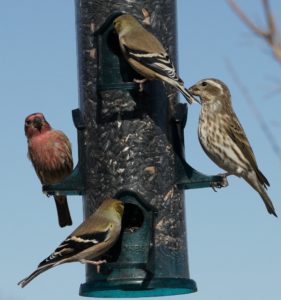
Finches enjoying sunflower seeds from a tube feeder.
- Spread cracked or whole corn scattered on the ground for corvids (crows, ravens, and jays) and blackbirds. Wild turkeys come into my yard for corn. Corn will also attract a variety of other animals such as deer, so be aware. If you don’t want deer, opossums, and raccoons in your yard at night, ensure you don’t put out more corn than will get eaten by your birds during the day.
- Offer wild birdseed mixes on the ground or low, flat feeders for juncos, sparrows, cardinals, and other birds that prefer to scratch on the ground. When it is snowing, you will need to put more food out as it gets covered by the snowfall. Don’t let old food build up or get moldy as this can make your birds sick. As with tube feeders, clean flat feeders routinely, and if you spread the food on the ground, change the location occasionally and try to feed only what the birds will eat in a day.
- Provide suet in hanging suet feeders for woodpeckers, nuthatches, and wrens. Actually, many different birds eat suet, so don’t be surprised if you see a blue jay or chickadee on your suet feeders, too. Clean suet feeders routinely.
Keep an untidy landscape
Another way to provide birds with food is to keep an untidy garden over winter. Avoid dead-heading seed-producing flowers and grasses until spring. Leave old berries, fruit, and nuts in place. For many perennials, leaving dead foliage in place will help insulate them for winter, and seeds provide a food source for many songbirds. I love watching my goldfinches eating coneflower seeds and my chickadees picking the seeds out of my dead sunflowers. Cedar waxwings come through and feast on my pokeberries. I have a small acreage, and in certain areas we don’t mow the grass until spring (we keep it mowed near the house to lower our fire risk). The tall grass provides both food and shelter.
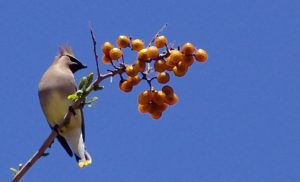
Cedar waxwings feed on fruits and berries.
Brush and leaf piles are very attractive to birds. If you can find a corner of your yard for a brush and/or leaf pile, this will provide a spot where birds can find both food and shelter. I don’t rake leaves anywhere on my acreage. It is fun to watch birds scratching and kicking the leaves around in their search for food and insects. It’s a great way to spot robins and sparrows: just look for the dancing leaves.
Bird feeder placement
Locate your bird feeders to avoid window hits. Here are some strategies to keep birds from hitting your windows:
- Place your birdfeeders far away from the house so birds have plenty of room to fly, even if panicked by a predator such as a hawk swooping through.
- Hang birdfeeders right next to your windows. If a bird does hit, it will not do so with enough momentum to hurt itself.
- Locate your birdfeeders opposite a windowless part of your house.
- Keep screens on your windows.
- Keep drapes and blinds closed.
Suet and other feeders should be located to prevent window hits.
A note of caution
One last note about providing food in winter. If you start feeding birds, try to keep it up during the harshest weather. If birds begin relying on you for food in their daily routine, suddenly taking that food source away when temperatures are at their worst could be problematic. For example, birds may expend energy to visit your yard every day. If they expend that energy for nothing, it is a potentially costly trip for them that would have been better spent foraging elsewhere. It’s just something to keep in mind: Once you start helping, keep helping, because they really may rely on your assistance.
Providing water
When temperatures drop below freezing or in areas experiencing drought, providing melted water is a very important way to help birds. Adding water to the landscape is an easy way to attract wildlife.
Heated bird baths are available commercially. Most are electric and require a cord connecting to an outlet somewhere. Some are battery operated, and I’ve even seen a few that are solar-powered. If you like to have a decorative water source, a heated birdbath is recommended.
Concrete birdbaths do not work very well in freezing weather. They are difficult to empty once the water freezes over. Only use concrete birdbaths if you have a safe way of heating them, or temperatures aren’t freezing during the day.
If you break the ice on a pond or other water feature, provide a perch or some way for birds to access the water without falling in or getting stuck. Avoid making birds perch on ice or icy surfaces to access the water.
Whatever water source you provide, ensure it is shallow enough that birds won’t be injured or drown if they accidentally fall in. Also ensure it has a nice rim or object on which they can perch. I actually use an old frying pan that is easy to empty and refill.
Providing shelter
Many birds, singly or in groups, will shelter in cavities, holes, or abandoned buildings on cold nights and during bad weather. They often use bird nesting boxes (bird houses). So, I ensure my bird houses are in good shape and cleaned out in fall. Some bird houses come with an option to add a perch over winter.
If you have a property with dead trees or dead branches and can safely leave them in place, woodpeckers will hollow out cavities that provide shelter and nesting holes for many different birds.
Tall grasses will provide shelter to quail, sparrows, and other birds. Brush piles will help wrens and a variety of birds.
By providing food, water, and shelter, you will attract many birds to your landscape and help them survive the harshest winter.
Meet Leslie Miller
Leslie Ann Miller shares 3.5 acres in rural Oklahoma with birds, butterflies and wide variety of animals. She is currently transforming her yard with plantings…
Leslie's Recent Posts
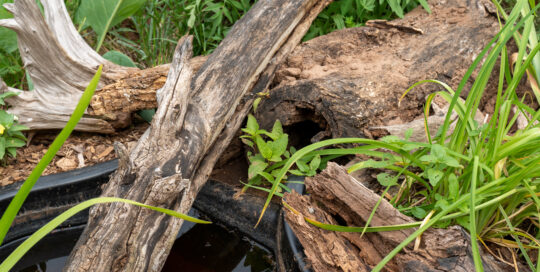
Creating microclimates and microhabitats to benefit wildlife


